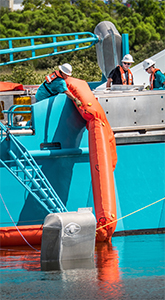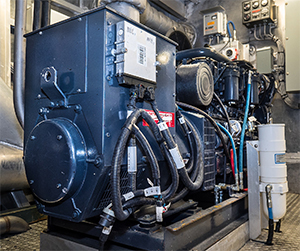The 95-foot J.L. O’Brien, delivered in February, is the fourth oil spill response vessel (OSRV) built by Midship Marine Inc. for Clean Gulf Associates, a nonprofit cooperative in New Orleans. The $5 million boat is docked in Leeville, La., next to the offshore hub of Port Fourchon, for around-the-clock cleanups in the Gulf of Mexico.
Rick Hinojosa, design manager at Midship Marine in Harvey, La., explained how his company landed the work. “After we repaired a CGA vessel seven years ago, CGA management asked us for price quotes to build three (Coast Guard)-approved, live-aboard 95-foot oil skimmers,” he said. “Until then, no vessels like that had been built. There were hurdles to cross, particularly because live-aboard skimmers are typically constructed of steel, which easily meets fire criteria.”
 |
|
Capt. Kyle Plaisance turns on J.L. O’Brien’s bridge electronics. In addition to the latest navigation equipment, the 95-foot OSRV has an infrared system for detecting oil spills at night. |
|
Brian Gauvin |
After meetings with the Coast Guard, plans were hammered out and construction began on the nation’s first fleet of all-aluminum OSRVs. “Our goal was to make these vessels user-friendly and not complicated to operate,” Hinojosa said. “It was a joint effort between us and CGA to accomplish this.”
In April 2013, Midship delivered Breton Island, following H.I. Rich and Galveston Island in the series. The boats, positioned in Venice, La., the Port of Vermilion, La., and Galveston, Texas, respectively, exceeded everyone’s expectations, Hinojosa said.
 |
|
Crewmembers retrieve the OSRV’s port skimmer boom on Bayou LaFourche. The vessel can recover more than 22,000 barrels of oil per day. |
|
Brian Gauvin |
“Then CGA contracted us to build M/V O’Brien,” he said. “The first three vessels were performing well, and they were the building blocks for this new boat. CGA wanted room for more fuel, which we accommodated by putting two more (500-gallon) fuel tanks in the stern of the boat.” The cabin on J.L. O’Brien is also about 2 feet wider and 3 feet longer than its predecessors, said CGA President Frank Paskewich.
Because the vessels have electronic equipment that locates oil, they need to maintain a stable base in all sea states. “Head-on into the sea, the first three boats were satisfactory,” Hinojosa said. “But in a side sea, they rolled too much for oil-spotting equipment to work well.”
To solve the problem, CGA asked Midship to install a Seakeeper 35 gyrostabilizer on J.L. O’Brien. “It addresses a side sea and lessens the roll of the vessel,” Hinojosa said. “The difference in sea trials with the Seakeeper unit engaged was like night and day, so much so that we’re now installing Seakeepers in the first three boats.”
[ J.L. O'Brien: Responding in the Gulf ]
 |
|
Capt. Curtis Bruce starts one of J.L. O’Brien’s Caterpillar C32 main engines. |
|
Brian Gauvin |
Paskewich said the gyrostabilizer reduces J.L. O’Brien’s roll by about 70 percent. Maggie Meredith, marketing manager for Maryland-based Seakeeper, said the additional stability “increases crew safety and eliminates seasickness. It reduces fatigue since crewmembers don’t have to fight the roll. The crew can spend more time on the water, fulfilling (their) mission.”
 |
|
J.L. O’Brien’s Seakeeper 35 gyrostabilizer decreases its roll by about 70 percent, an improvement that has led Clean Gulf Associates to install the system on the boat’s series predecessors in the Gulf. |
|
Brian Gauvin |
For spill cleanup, J.L. O’Brien has two side-mounted, three-brush skimmers from Lamor of Finland. The equipment allows oil to stick to the bristles while excess water is repelled. The oil is then scraped into a sump and pumped into a 249-barrel holding tank for offloading. The boat also has a MarQuipt deck crane and an infrared oil-detection system for tracking at night.
J.L. O’Brien has yet to be put to the test in an actual oil spill in the Gulf. Fortunately, the spills that CGA responds to have declined since the Deepwater Horizon disaster in April 2010, Paskewich said. The group sent virtually all of its assets to that Gulf well blowout, where they stayed for more than three months. CGA has aided in other incidents, including a 9,000-barrel Mississippi River spill when the tanker Tintomara collided with the towboat Mel Oliver and barge DM 932 in New Orleans in July 2008, and a platform fire off the coast of Venice, La., in May 2015.
“In our operation, crews pre-positioned on the Gulf can mobilize resources within two hours of notice,” Paskewich said. J.L. O’Brien is home-ported in the “epicenter” of oil and gas production in the region, he added, allowing CGA to rapidly get necessary resources on the scene.
 |
|
Auxiliary power on the response vessel is provided by a pair of Northern Lights 65-kW generators. |
|
Brian Gauvin |
The new response vessel is named after Jim O’Brien, a former Coast Guard officer who died in 2014. He founded an oil pollution service in Slidell, La., in 1983 and provided training and response services to clients around the world. O’Brien developed cleanup techniques and equipment that are widely used today.
In addition to oil skimmers, Midship Marine builds aluminum passenger ferries, crew boats and sailboats. “Passenger ferries have been our constant in recent years because oil field needs are unpredictable with the ups and downs in oil prices,” Hinojosa said.
 |
|
J.L. O’Brien heads out for a cleanup drill on Bayou LaFourche. The newbuild from Midship Marine carries the name of one of the world’s pioneers in oil spill response. |
|
Brian Gauvin |

